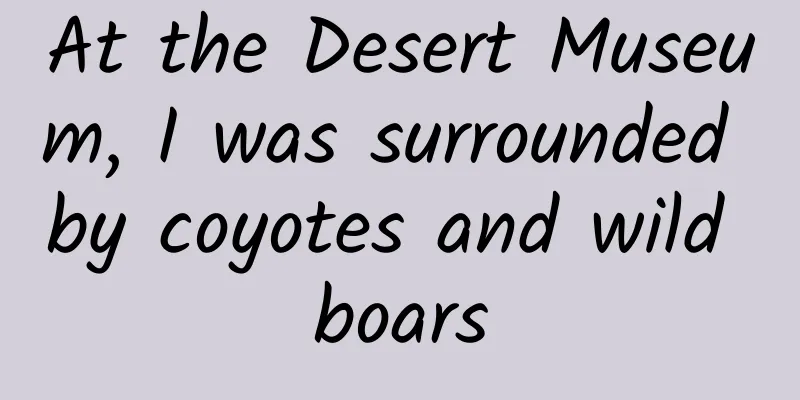At the Desert Museum, I was surrounded by coyotes and wild boars

|
What does a desert look like? You may think of the desolate scene of "the smoke rising in the desert, the setting sun over the long river", or the poem "the sand in the desert is like snow, the moon in Yanshan is like a hook". The sand dunes and Gobi desert with no grass growing under the scorching sun have become the "standard image" of the desert in people's minds. Desert photo | alain richet / flickr But in fact, the ecology of the desert can be enriched enough to open a world-class botanical garden or build a famous museum! The Desert Botanical Garden and the Arizona Sonora Desert Museum in Arizona, USA, are such unique and charming places. Entrance to Desert Botanical Garden | Plum The Desert Botanical Garden is located in the eastern suburbs of Phoenix, the capital of Arizona; the Sonoran Desert Museum is located next to Saguaro National Park in southern Arizona, very close to Tucson. In early January when other places in North America were covered in snow and ice, I visited the warm Sun Valley, where the weather was neither too hot nor too cold, which was perfect. I had already put these two famous nature-related attractions on my wish list. All about the weird cactus As soon as the plane landed, the scorching and dryness that is unique to the southwest desert hit us. The grass and trees disappeared, replaced by low shrubs, succulents, and bare soil and stones; while driving on the road, the green trunks and sparse branches of the Palo verde (literally translated as "green sticks" in Spanish) on the roadside were very eye-catching, and occasionally one or two tall cacti - giant saguaro - would appear. All of these were more thoroughly and richly displayed in the Desert Botanical Garden. The tall giant saguaro (Carnegiea gigantea) | Gentry George / WIkimedia Commons Not only that, when I visited the botanical garden, there was an exhibition of the famous glass artist Dale Chihuly. The bizarre glass products placed among the various cacti also had a unique flavor. Bizarre exhibits | Plum There is a pavilion in the botanical garden that displays a variety of cacti, many of which are rare species. I also learned here that most of the species of Caryophyllales and Cactaceae are unique to the American continent (only one is distributed in the wild on the African continent, which is suspected to have been brought by humans). However, there are many plants with thorns, so what is special about cacti? The answer lies in the way the cactus thorns grow - these thorns grow radially in clusters from the unique "Areole", and the thorns are its "leaves". The explanation of the characteristics of cactus on the display board. All the display boards here are in English and Spanish | Li Zi The internal structure of the cactus also supports its survival in the desert. The wooden stem in the middle, which is like a "skeleton", together with the thorns that save water evaporation and prevent animals from biting, and the stem that can store a lot of water, constitute the basic elements of the cactus. An explanation of the basic structure of a cactus. | Plum After understanding the basic structure, the various strange shapes of cacti in the park further demonstrate the richness and diversity of nature, which is a feast for the eyes. (Many cacti are named very directly!) The Cactus Pavilion not only has rare cacti, but also has popular science panels on many species and organisms | Plum A kind of "lying flat" cactus, in fact, people call it "creeping devil" (Stenocereus eruca), doesn't it have that flavor? | Plum ‘Octopus Cactus’ (Stenocereus Alamosensis) | Plum Other succulents are also present, after all, they are "neighbors" in the same ecosystem. Explanation on "Where are the most fleshy" in succulent plants | Plum Rare plants from Africa: Sunset Aloe, very beautiful colors | Plum An interesting point is that the Aloe vera native to the African continent and the Agave native to the American continent are actually very distantly related, but their appearance is similar. The botanical garden also used these two as examples to clearly introduce the concept of "convergent evolution", which is really excellent. Agave (left) vs Aloe Vera (right) | Plum There’s a lot more to the desert than just cacti! After visiting the Desert Botanical Garden and the Sonoran Desert Museum, I did learn more about cacti and succulents. But what is even more valuable is that both botanical gardens/museums have carefully integrated the concept of "native desert ecology" into their exhibitions. This desert in Arizona is called "Sonora". It coexists with three other desert ecosystems (the Great Basin Desert in Nevada and Utah, the Mojave Desert in southern California, and the Chihuahuan Desert in southern New Mexico) in the southwestern United States. Each desert has its own unique appearance. A corner of the Desert Botanical Garden, typical plants appear! | Plum What's so special about the Sonoran Desert? Take a walk through the ecological trails at the Desert Botanical Garden and you'll find out. The Sonoran Desert is not just a desert, it's also divided into many smaller sub-ecologies. Desert Ecological Trail | Plum The desert where the giant saguaros stand is home to various cacti and drought-resistant creosote trees. In places where the groundwater level is relatively high, there grows a tree called Mesquite, which has fine leaves and an unassuming posture, and is very interesting. Where there are rivers, there are desert oases, where you can see cattails, reeds, cottonwoods and willows. Desert Oasis Ecology | Plum On the western edge of the desert, at a slightly higher altitude, there are semi-desert meadows where acacias, yuccas, etc. grow; while in the higher north, there are evergreen broad-leaved shrubs called "Chaparral", where there are more agaves, cypresses, and stone orchids. Evergreen shrub ecology | Plum On this one-kilometer-long trail, the five sub-ecologies are arranged in sequence, and the plants of different heights and the introductions everywhere allow people to fully understand the most common typical plants in each ecology. After I walked this trail, the novelty and surprise I felt when I first landed in Arizona quickly turned into familiarity, and the distance between me and the surrounding environment shortened a lot. Introduction to the five sub-ecologies of the Sonoran Desert | Plum Among them, the deciduous trees in the Arizona oasis turn yellow in late December and early January, looking quite similar to autumn in other places. Coincidentally, the Sonoran Desert Museum also has such a setting. On the semi-outdoor display boards, the museum introduces the geology and geography of the Sonoran Desert in detail - it will be more rewarding to stop and learn before visiting the "real desert". Sonoran Desert Museum Entrance | Plum We learned from the display board that, in fact, the Sonoran Desert is the desert with the most "abundant" rainfall among the four deserts (about 200-400mm per year). The water vapor from the Gulf of California (the thin bay of water in western Mexico) brings a relatively humid late summer and early winter to this desert every year. And those giant saguaro cacti can take this opportunity to absorb enough water. In years with sufficient rainfall, there will be many wild flowers blooming in the early spring and late summer of the desert. Popular science display board introducing desert ecology | Li Zi Map of desert ecology | Plum The ocotillo tree looks like dead branches in the dry season, but its flowers are very bright! Mexican thornwood before flowering | Plum Mexican thornwood with small red flowers | Britannica.com The Desert Museum also has a desert trail. Unlike the botanical garden, which emphasizes sub-ecology, this trail mainly displays desert ecology, with occasional shrubs and a small amount of mesquite trees. Desert Trails at the Desert Museum | Plum The most unique feature is that in this desert trail that is similar to the wild, there are some small animals commonly found in the desert - coyotes, javelina and some lizards. These animals live completely in the wild environment, separated from the trail by only a thin net (more like the trail itself, that is, us, is fenced off, not the animals). In addition to popular science about animals, the display boards beside the trail also have tips on "how to find them." The museum also kindly reminds you: "You may not be able to see them every time." If you can't find them, come back next time! Luckily, I saw coyotes and several wild boars. Coyote in the Brushwood | Plum When the sun is high, wild boars like to hide in the shade of bushes and cacti, and usually have fixed haunts. This is also fully described on the trail signs to help people find the hiding wild boars. Tips on how to find wild boar | Plums When I went there, there were two wild boars foraging in the bushes, and a few others were lying down leisurely after eating. They looked very cute. But in fact, even Bolt can't catch up with them when they run! (It's true.) Wild boar foraging in the bush | Plum The sleeping piglet | Plum Calendar Girl's Tips Calendar Girl: The wild boars called "javelina" in the Americas belong to the family Tayassuidae, while the wild boars in my country belong to the family Suidae. Compared with wild boars in the Suidae family, the American wild boars are smaller, have shorter heads, and their tusks point downwards instead of curving upwards like wild boars. The Sonoran Desert Museum is actually more like a combination of a botanical garden, a zoo, an aquarium and a geological museum. Most of the exhibitions are placed outdoors, and viewing points are set up in many places, allowing people to observe and learn the characteristics of various environments in an almost native natural environment. A mountain lion napping with its back to me | Plum Mexican gray wolf on the move | Plum The animals that need to be kept in captivity are also local species, and they are fully enriched with local plants and topographic features. Although there are not many animals, there are only cougars, Mexican gray wolves, gray foxes, desert bighorn sheep, North American bobcats, etc. They are not "rare" species, but combined with the explanation of the local ecological environment, it is still quite rewarding. Cute Gray Fox | Plum Desert Bighorn Sheep | Plum As for geology, a lifelike underground cave exhibition hall is used to display geological landscapes such as stalactite caves, crystal caves, and shales embedded with fossils, as well as various minerals dug out locally. Stalactite Cave | Plum Local Mineral Show | Plum In the outdoor geology section, there is a display board leading the audience to look toward the other side of the mountain, explaining the origin of the red rocks - this place used to be a swamp during the dinosaur era, and over the years, the swamp petrified into rock layers and became what it is today. Outdoor exhibition, with several iron pipe "telescopes" on the left, through which you can point to the red rocks opposite | Li Zi The aquarium displays fish from local rivers and desert oases, as well as animals such as beavers and otters. Although it is relatively small in scale, it is combined with the display of natural ecology and is very "organic". How to live in harmony with nature Of course, since they are botanical gardens and museums with natural themes, it is essential to emphasize environmental protection. However, the environmental protection content in these two gardens is more subtle and highlights the theme of how local people get along with nature. The aforementioned Desert Botanical Garden Ecological Trail incorporates a lot of information about how the indigenous people adapt to the natural ecology. People's survival materials are taken from various things in the natural environment, and they have developed a lifestyle with local characteristics - for example, they use the fruits of various cacti, plant agave and extract sugar from the rhizomes to make wine, use legumes to fix nitrogen in the land, etc. The emphasis on ecological wisdom in indigenous culture is refreshing. The indigenous people built a pergola with local materials outdoors to rest between the cactus harvest | Plum The Sonoran Desert Museum has arranged a "Bee Garden" and a "Hummingbird Garden" to talk about the importance of pollinators to desert ecology. Yes, there are many plants with flowers and fruits in the desert, and people can also plant more native flowers and plants in their backyards to provide food for bees and hummingbirds. Bee Garden, unfortunately there are not many flowers in this season, so there are no bees... | Plum The hummingbird garden is especially worth a visit. I have never seen so many hummingbirds in one go! There are five common hummingbird species in the Sonoran Desert, and this garden has a total of eight species, all of which have successfully bred here. In order to create a breeding environment for these hummingbirds, spiders were specially introduced into the garden, and the webs they weave will be used by the hummingbirds as "building materials" to build nests. An Anna's hummingbird (Calypte anna) | desertmuseum.org In short, after visiting the Desert Botanical Garden and the Sonoran Desert Museum in one go, the scene in front of me has a different meaning. The Arizona desert is indeed unique and charming, but in fact, every habitat on the earth has its own unique features. At least, it made me think more about what is special about the environment we live in every day and what our relationship with the environment is like. On this basis, we will truly start from the small things around us, sympathize with the importance of protecting the environment, and make efforts little by little. Taking an excited selfie at the Sonoran Desert Museum | Plum (A little gossip: When I was at a meeting at Arizona State University (ASU), I happened to meet several curators for botanical gardens and museums, who also have a cooperative relationship with ASU. They specifically mentioned that in recent years, they have developed many exhibitions that are very characteristic of the state and the local area. I naturally praised this and asked casually: Why did you choose to go this way? The answer is that the Arizona state government has been a major funder in recent years...) Sunset in Saguaro National Park | Plum Finally, here are some tips for sightseeing: Most of the Desert Botanical Garden and Sonoran Desert Museum are outdoors. If you visit during summer or autumn, please be sure to wear sunscreen and bring plenty of drinking water. However, there are plenty of water refilling points in the park, so you can bring your own water bottle. If you go to the Sonoran Desert Museum, you can also pass by the nearby Saguaro National Park, where there are many spectacular hiking routes to choose from. Both parks are suitable for all ages, combining education with entertainment, and there are many places for children to play. In particular, the volunteers at the Sonoran Desert Museum are very enthusiastic and knowledgeable, and you can talk to them more. The Desert Botanical Garden also has tours and entertainment activities at night, which is a great place for nightlife (really!) Author: Li Zi Editor: Jianer This article comes from the Species Calendar, welcome to forward If you need to reprint, please contact [email protected] |
<<: Don't buy this kind of bird! Someone has been caught
>>: Bug alert! The bugs that have been hiding for the winter are coming out!!!
Recommend
How to transfer files between iPhone 12 and Windows without using apps
[[408549]] For Apple users, in daily work, they o...
Airplanes are becoming more and more bumpy. Is this really due to climate change?
© The Wall Street Journal Leviathan Press: A few ...
Just look up for 1 second and you will be happy instantly! You must try this 0-cost stress relief method
In our busy lives, we always keep our heads down,...
Still have no idea about operations? An article to help you sort out your thoughts
The operation work is fragmented and disorganized...
He is the first Chinese to win the "Nobel Prize for Meteorology" and made a bold statement: "Let foreigners catch up with us"|Time Letter
Nowadays, weather forecast has become a piece of ...
Can eating more duck eggs lower blood pressure? The truth is...
Rumor: "People with high blood pressure shou...
Hundreds of millions of people are lactose intolerant, so why are we still recommending you to drink milk?
There is no need to say much about the benefits o...
2021 Jiebao linkage system course "Leopard Brother Short-term Practical System Course" and "Jiebao Trading System Advanced Edition" video + handouts
2021 Jiebao linkage system course "Leopard B...
Detailed explanation of Apple Developer Conference: What are the stories behind iOS 14? Why launch self-developed chips now?
In the early morning of June 23rd, Beijing time, ...
A simple trick to quickly increase your title open rate!
No matter what I say. No matter how good the cont...
Online production of Ukrainian beauties holding signs and shouting videos, online orders, sincerely recruiting agents!
The beauty sign-holding team includes the Russian...
Why do iPhones often break down in low temperatures? It turns out it’s not Apple’s fault
Recently, there have been many discussions about ...
A quick guide to time management: Manage your time and become the master of it
Everyone is a manager of time, but most people ju...
Why do our fingers or toes get wrinkled after being in water for a while?
If the hairless skin on a person's fingers, t...









